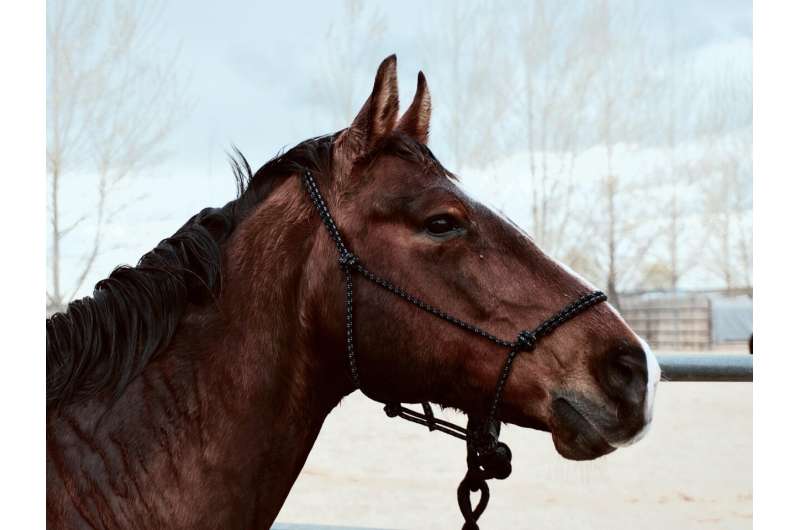Anaesthetic-related mortality in horses cut by half in the past 20 years

CEPEF4 is the largest study globally on anesthetic-related mortality in horses. Three researchers from the Faculties of Veterinary Studies of Edinburgh, Zurich and the CEU Cardenal Herrera of Valencia, along with the two British authors who founded the study, have just published in journal Animals the preliminary results on the first 6,701 cases of anesthesia and 1,995 cases of sedation registered. According to CEU UCH Veterinary Anaesthesiology professor José Ignacio Redondo, co-author of CEPEF4, "this initial data reveals an encouraging and significant decrease in equestrian anesthetic-related mortality, down from 1.9 percent to 1 percent, and to just 0.2 percent of animals in the cases of procedures conducted under sedation."
The fourth edition of the CEPEF project is led by Miguel Gozalo-Marcilla, head of Anesthetics in the equine section of the Faculty of Veterinary Studies in Edinburgh. Also taking part were Regula Bettschart-Wolfensberger, Anaesthesiology professor at the Faculty of Veterinary Studies of Zurich, José Ignacio-Redondo and Vetstream director Mark Johnston, lead author of the first three editions of the CEPEF along with globally renown equestrian anesthesia specialist, doctor Polly M. Taylor.
Breakthroughs in equestrian anesthesia and sedation protocols
For professor Redondo, "there is still room for the anesthesia-related mortality in this species to decrease further, down to the levels where the anesthesia in small animals currently sits." In this sense, professor José Ignacio Redondo leads the COMPLRED international study, which detected that, globally, the anesthetic-related mortality is at 0.75 percent in dogs and 0.68 percent in cats, after analyzing over 61,000 cases in veterinarian centers worldwide.
Also relevant among the preliminary results of CEPEF4 that have now been published in Animals are the descriptive data of the progress of anesthetic and sedation techniques applied to horses internationally, compared to previous editions of the study. "The preliminary data already verifies that these new anesthetic techniques and protocols are contributing to successfully decrease the anesthetic-related mortality in horses."
Online cases and Big Data techniques during the pandemic
In just 11 months and in the tough context of the pandemic, thanks to the technique of registering cases using a digital form designed for this purpose, the CEPEF4 study has managed to gather almost 20,000 cases of equestrian anesthesia from over 70 veterinarian clinics in 20 countries and 4 continents, making it the largest study globally regarding the representativeness of the sample. Countries such as Belgium, the United Kingdom, Ireland, France, the United States, Argentina, Australia, Switzerland and Spain are the ones who provide the most data. This form allows veterinarians from around the world to register the relevant clinical parameters of the horses they apply anesthetic techniques to from their mobile phone, tablet or computer.
Another of the significant technological breakthroughs since the first editions of CEPEF, which began 20 years ago, is the addition of Big Data and machine learning techniques for the mass processing of registered data. "The artificial intelligence used makes it possible to analyze data in a mass way and detect the most significant pieces of data among them, to identify the evolution of the risks of anesthesia practically in real time, which allows us to continue improving the safety of anesthesia in horses," notes CEU UCH professor José Ignacio Redondo. In the meeting of the research team, held in the campus of the CEU UCH in Valencia, the authors of the CEPEF4 study have planned the next stages of the study, with two main goals: to reach 50,000 anaesthesias performed and to conduct partial studies on several aspects of equestrian anesthesia, not only those linked to mortality, which can also be extracted from the large volume of data on equestrian anesthesia that they are registering in the study from collaborating clinics and veterinarian centers from around the world.
More information: Miguel Gozalo-Marcilla et al, Data Collection for the Fourth Multicentre Confidential Enquiry into Perioperative Equine Fatalities (CEPEF4) Study: New Technology and Preliminary Results, Animals (2021). DOI: 10.3390/ani11092549
Provided by Asociacion RUVID


















